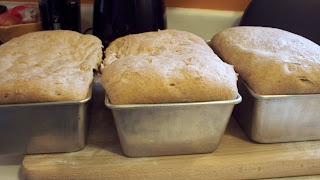I bought a Kitchenaid mixer last week. This is big news! This means I can make cakes
all the time without having to borrow my friend's Sunbeam mixer from the '70s which works, but is not nearly as amazing as the Kitchenaid!!!
My friend had a squid eating party last weekend. I don't eat squid (squid and octopuses are the only thing I don't eat because they are too cute to eat...) and in protest I made a cake. I wanted a cake that would be sand colored, and rum cake fit the bill! This is from my
favorite cakebook again because I am kind of on a mission to make all the cakes from it... Like all the other cakes I've made from this book, this one was delish!! It is very rich and doesn't reallllly need frosting (I glazed AND frosted it!) but I wanted to frost it to send my message. This would be quite good as a bundt cake, or other cake with a fun shaped pan.
 Rum Runner Cake
Rum Runner CakeIngredients:
Dry2 3/4 cups flour
1/4 cup packed muscovado (or dark brown) sugar
2 Tbsp potato starch
1 tsp vanilla powder (I didn't have this so I just increased the vanilla extract to 1 Tbsp)
1/2 tsp salt
1/2 tsp cinnamon
1/4 tsp baking soda
Liquid1 cup sour cream (I didn't have quite a cup, so I filled the rest of the cup with half and half that I had lying around, but yogurt is also a good substitute!)
3/4 cup heavy cream
1/4 cup dark rum (use
THE KRAKEN rum if you can, especially when making cephalopod themed cakes!!)
1 tsp molasses
1 tsp vanilla (or more if you don't have vanilla powder
Creaming2 sticks unsalted butter
2 1/2 cups white sugar
seeds from 1/2 vanilla bean, slice bean down the middle and scrape the tiny seeds out, save the pod!
4 whole eggs
2 egg yolks (save whites for buttercream or omlettes!)
Glaze1/4 cup simple syrup
1/4 cup rum
Directions:
1. Preheat oven to 350.
2. Line two 8 inch cake pans with parchment paper, don't grease! Or, if you are making a bundt, grease and flour or spray with a baking spray that already has flour in it.
3. Put all dry ingredients in a bowl and whisk to combine. Do the same with the liquid ingredients in a separate bowl.
4. Cream butter and white sugar for 3 minutes on low speed.
5. Add vanilla seeds.
6. Add eggs followed by yolks one at a time, incorporating fully after adding each one.
7. Stop the mixer and scrape the sides and bottom of the bowl.
8. Turn the mixer on medium low and quickly add the dry ingredients and liquid ingredients in 3-4 additions each, starting with the dry and ending with the dry.
9. Stop the mixer and scrape the sides and bottom of the bowl.
10. Mix on medium for 20 seconds.
11. Pour the batter into the pan(s). Bake the 8" pans for about 30-35 minutes (my oven is sketchy, so keep checking) and a bundt for 50 minutes (according to the book) or until the top isn't jiggly and the cake passes the toothpick test.
12. Allow the cake to cool for about 10 minutes in the pan before removing to cool completely.
13. For the glaze, mix 1/4 cup simple syrup* and 1/4 cup rum. After removing the cake(s) from the pans, pour the glaze over evenly (use a brush if you have one) and allow it to fully soak in.
Rum ButtercreamI am lazy and don't want to retype the recipe, but it's exactly the same as the Amaretto Buttercream from
the banana cake but I used 1/4 cup dark rum instead of amaretto and 2 Tbsp vanilla. My plan was to cut back the butter, so I reduced it to 3 sticks. The texture was
bad. It was way too meringue-y. So I added the last stick of butter and just as I added the last tablespoon, the texture totally changed, so I guess there is some science in this! I used TJ's butter instead of Ralph's and lo and behold, it didn't taste so buttery! So I think the type of butter does matter, but you can add flour anyway if it's too buttery tasting. And if you want to add color, I strongly suggest using the gel because a) it's much more concentrated color and b) the liquid color doesn't mix well with such a buttery frosting! It will eventually after a lot of mixing, but you know... oil and water!
Assembling the cake!1. Cut tops off of the cake (so they are flat) and eat them! (I never do this, but you are sort of supposed to for nicer looking cakes...)
2. Put one of the cakes on a cake plate.
3. Put a thick layer of frosting on the cake.
4. Put the other cake on top of the frosting.
5. Frost the tops and sides.
6. Add red food coloring to the blue frosting until you get a contrasting color. Decorate with a sad squid.
I always mean to take pictures of the inside of the cake, but it usually gets destroyed in the cutting process. But here it is! The dark clump is muscovado sugar that didn't get fully worked in... don't be lazy with your ingredients like me!

*To make simple syrup: Combine 2 cups white sugar and 1.25 cups water in a saucepan. Add the vanilla bean pod if you want vanilla syrup (this smells SO GOOD)! Bring to a simmer over medium heat and then immediately remove from the heat and allow to cool. Store in the fridge.




















